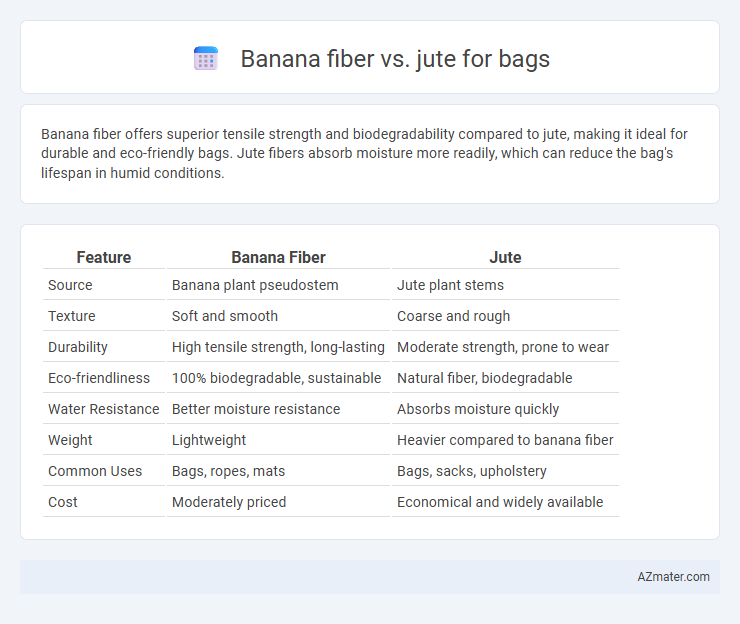Banana fiber offers superior tensile strength and biodegradability compared to jute, making it ideal for durable and eco-friendly bags. Jute fibers absorb moisture more readily, which can reduce the bag's lifespan in humid conditions.
Table of Comparison
| Feature | Banana Fiber | Jute |
|---|---|---|
| Source | Banana plant pseudostem | Jute plant stems |
| Texture | Soft and smooth | Coarse and rough |
| Durability | High tensile strength, long-lasting | Moderate strength, prone to wear |
| Eco-friendliness | 100% biodegradable, sustainable | Natural fiber, biodegradable |
| Water Resistance | Better moisture resistance | Absorbs moisture quickly |
| Weight | Lightweight | Heavier compared to banana fiber |
| Common Uses | Bags, ropes, mats | Bags, sacks, upholstery |
| Cost | Moderately priced | Economical and widely available |
Introduction to Banana Fiber and Jute
Banana fiber, extracted from the pseudostem of the banana plant, offers a natural, sustainable alternative for bag production with high tensile strength and durability. Jute, known as the "golden fiber," is derived from the outer bast of the jute plant and is widely recognized for its eco-friendly, biodegradable properties and affordability. Both fibers are renewable and popular choices in eco-conscious fashion, with banana fiber often praised for its smooth texture and jute for its coarse, rustic appearance.
Origin and Sourcing of Banana Fiber and Jute
Banana fiber is derived from the pseudostem of the banana plant, primarily sourced from regions in India, the Philippines, and Nepal where banana cultivation is abundant. Jute, a natural bast fiber, originates from the Corchorus plant, predominantly grown in Bangladesh, India, and parts of Southeast Asia. Both fibers are sustainably harvested as by-products of agricultural practices, with banana fiber offering an eco-friendly alternative due to its utilization of banana plant waste after fruit harvest.
Fiber Extraction Processes Compared
Banana fiber extraction involves retting and scraping the pseudostem to separate the long, strong fibers, resulting in a softer, more flexible material suitable for bags. Jute fiber extraction primarily uses water retting to loosen the outer stem layer, producing coarse yet durable fibers commonly used in heavy-duty bags. The banana fiber process requires more manual labor and is eco-friendlier due to less water usage, while jute extraction is more industrialized, yielding higher fiber volume per plant.
Sustainability and Environmental Impact
Banana fiber bags offer a sustainable alternative due to their biodegradable nature and the use of agricultural waste, reducing environmental impact compared to jute, which requires more water and pesticide use during cultivation. The extraction of banana fiber promotes waste valorization and conserves soil health, whereas jute farming often leads to soil degradation and higher carbon emissions. Choosing banana fiber bags supports eco-friendly production practices and decreases the overall ecological footprint in the textile industry.
Durability and Strength Analysis
Banana fiber exhibits higher tensile strength and durability compared to jute, making it more resistant to wear and tear in bag manufacturing. Its long, strong fibers contribute to enhanced longevity and better load-bearing capacity, ideal for heavy or frequently used bags. Jute, although sturdy and eco-friendly, tends to degrade faster under moisture and heavy strain, limiting its durability in comparison to banana fiber.
Visual Appeal: Texture and Color Differences
Banana fiber offers a smooth texture with a natural sheen, showcasing a light cream to pale yellow color that gives bags a refined and elegant visual appeal. Jute features a coarse, rough texture with a dense weave and earthy brown to golden hues, imparting a rustic and natural charm to bags. The contrast in texture and color between banana fiber and jute significantly influences the aesthetic style, where banana fiber suits sleek, modern designs while jute is favored for traditional, eco-friendly looks.
Weight and Comfort in Bag Applications
Banana fiber offers a lightweight alternative to jute, making bags easier to carry without compromising durability. Its natural softness enhances comfort during prolonged use compared to the rougher texture of jute fibers. Banana fiber's breathable properties improve user experience by reducing stiffness and weight, optimal for bags designed for daily wear.
Cost-Effectiveness and Market Availability
Banana fiber offers a competitive cost advantage over jute due to its faster cultivation cycle and utilization of agricultural waste, resulting in lower raw material expenses. Jute remains widely available in established markets with extensive supply chains, but banana fiber is gaining traction in niche eco-friendly sectors, enhancing its market presence. For sustainable bag production, banana fiber provides a cost-effective alternative where regional availability aligns with growing consumer demand for biodegradable materials.
Popular Uses in the Fashion Industry
Banana fiber and jute are both sustainable materials widely used in the fashion industry for eco-friendly bags. Banana fiber is favored for its durability and smooth texture, making it ideal for high-end handbags and accessories, while jute's coarse, rustic appearance suits casual tote bags and market carriers. Designers leverage banana fiber for lightweight, luxurious finishes, whereas jute remains popular for its affordability and strong, breathable qualities.
Consumer Preferences and Future Trends
Banana fiber bags appeal to eco-conscious consumers due to their natural durability, biodegradability, and unique texture, offering a sustainable alternative to traditional jute bags. Consumers increasingly prefer banana fiber for its lightweight nature and resistance to moisture, which enhances bag longevity compared to jute. Future trends indicate a growing market shift towards banana fiber, driven by rising demand for environmentally friendly products and innovations in fiber processing technology that improve texture and strength.

Infographic: Banana fiber vs Jute for Bag
 azmater.com
azmater.com